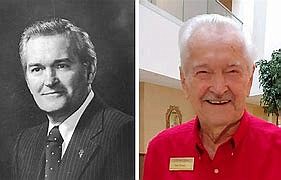(Editor's note: Second of two parts)
When Chattanooga Vice Mayor Charles A. "Pat" Rose announced his candidacy for the city's top post in 1975, he identified a nine-point platform committed to "a continuation of progress in the city." His target areas of emphasis included: "strict attention to the economy ... and no additional tax burden on our citizens; full municipal services in annexed areas as quickly as possible; openness and honesty in government; cooperation and harmonious working relationships with other governments to combine services where possible and save tax dollars," and other actions that would result in better management and conservative fiscal policies while reflecting Rose's "integrity and capability of leadership." The vice mayor acknowledged he had only seriously considered the office when "his friend, Mayor [Robert Kirk] Walker, declined to run for re-election," and he would continue the work begun by the former mayor.
In an election that featured five candidates for mayor -- Rose, Steve Conrad, Doug Brown, Glenn R. Copeland and James "Bookie" Turner -- Pat Rose emerged as the clear winner and set about to fulfill his platform, with the redevelopment of the central business district as his first target. Four years later, with a successful record, Rose was re-elected without opposition.
During his eight years in office, he oversaw the completion of the Chattanooga-Hamilton County Bicentennial Library -- a project begun by Mayor Walker -- and expansions of the TVA offices downtown on Market Street and the Moccasin Bend Waste Treatment plant, including the extension of city sewers. Understanding that Chattanoogans north of the Tennessee River needed an additional option for accessing the downtown area, Rose advocated for the construction of the C.B. Robinson Bridge, named in honor of the long-serving Chattanooga teacher, Hamilton County state legislator and founder of the Tennessee Black Caucus.
Working in partnership with the Lyndhurst Foundation, Mayor Rose began to explore viable options for "creating the Chattanooga" that would spotlight its natural geographic beauty, emerging strong economy and welcoming community. While on a European "research" trip with then-Chattanooga Area Economic Development Council general manager Ron Littlefield, funded by the Foundation, the two officials met the mayor of Indianapolis, William Hudnut. After lengthy conversations with the mayor regarding his city's "up-and-coming community," Mayor Rose organized a delegation of 52 people for an exploration trip to Indianapolis, seeking inspiration for Chattanooga's own revitalization. "Chattanooga Venture" was born, based on the idea of assembling citizens from different backgrounds and political affiliations to work together for the Chattanooga's "greater good." The result of that collaborative thinking was aptly named "Vision 2000."
The idea of the community working together seemed appropriate for a mayor who consistently worked to unite his commission. Former commissioners often commented that Mayor Rose would stress points of agreement on issues of contention and then push each member to truly analyze the opposing views. "Where can we meet?" was cited as a frequent question when the mayor was pushing for a unanimous vote, a signal to the constituents that their leadership was working together.
In January 1982, Pat Rose announced in a surprise conclusion to his State of the City address before his civic group, the Brainerd Kiwanis, that he would not seek re-election. "Carolyn and I have prayed earnestly for God's leadership in the matter of my running for the office of mayor again. As a result, I do not plan to be a candidate in next year's race." Adding that he had "enjoyed immensely serving the community I love for the past 17 years" and pledging to finish his current term "working as diligently as ever," Rose further explained his decision. Citing substantial cuts in federal and state funding that had impacted services, the mayor said his "primary goal" for the final year would be "to expand the economic base by creating a closer relationship with the private sector and our county government, to expand opportunities for existing businesses and to make a stronger effort to enlist private development."
True to his promise, Pat Rose did not seek re-election and quietly moved to the private sector, ultimately becoming executive director of Fountaingate Properties -- until four years later when, admitting "strong feelings that I have to serve and be involved in our community," he announced his candidacy for public utilities commissioner: "Since Commissioner Jim Eberle has decided not to run for re-election, I would like very much to serve as his successor." Two months later, former Mayor Pat Rose was elected to the commission and began working with Eberle to become "updated with current information."
Charles A. "Pat" Rose's service to his adopted community continued.
Linda Moss Mines is the official Chattanooga and Hamilton County historian.
